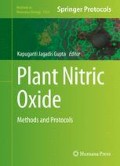Abstract
Chloroplasts are among the more active organelles involved in free energy transduction in plants (photophosphorylation). Nitric oxide (NO) generation by soybean (Glycine max, var ADM 4800) chloroplasts was measured as an endogenous product assessed by electron paramagnetic resonance (ESR) spin-trapping technique. ESR spectroscopy is a methodology employed to detect species with unpaired electrons (paramagnetic). This technology has been successfully applied to different plant tissues and subcellular compartments to asses both, NO content and generation. The spin trap MGD-Fe2+ is extensively employed to efficiently detect NO. Here, we describe a simple methodology to asses NO generation rate by isolated chloroplasts in the presence of either l-Arginine or nitrite (NO2 −) as substrates, since these compounds are required for enzymatic activities considered as the possible sources of NO generation in plants.
Access this chapter
Tax calculation will be finalised at checkout
Purchases are for personal use only
References
Rosen GM (1985) Use of spin trap in biological systems. Free Radic Biol Med 1:345–375
Moncada S, Palmer RMJ, Higgs EA (1991) Nitric oxide: physiology, pathophysiology and pharmacology. Pharmacol Rev 43:109–142
Stamler JS, Singel DJ, Loscalzo J (1992) Biochemistry of nitric oxide and its redox-activated forms. Science 258:1898–1902
Saran M, Michel C, Bors W (1990) Reaction of NO with O2. Implications for the action of endothelium-derived relaxing factor (EDRF). Free Radic Res Commun 10:221–222
Wink DA, Mitchell JB (1998) Chemical biology of nitric oxide: insights into regulatory, cytotoxic, and cytoprotective mechanisms of nitric oxide. Free Radic Biol Med 25:434–456
Davis KL, Martin E, Turko IV et al (2001) Novel effects of nitric oxide. Annu Rev Pharmacol Toxicol 41:203–236
Rubbo H, Parthasarathy S, Barnes S et al (1995) Nitric oxide inhibition of lipoxygenase-dependent liposome and low density lipoprotein oxidation: termination of radical chain propagation reactions and formation of nitrogen containing oxidized lipid derivatives. Arch Biochem Biophys 324:15–25
Gisone P, Dubner D, Pérez MR et al (2004) The role of nitric oxide in the radiation-induced effects in the developing brain. In Vivo 18:281–292
Grisham MB, Johnson GG, Lancaster JR Jr (1996) Quantitation of nitrate and nitrite in extracellular fluids. Methods Enzymol 268:237–246
Miles AM, Wink DA, Cook JC et al (1996) Determination of nitric oxide using fluorescence spectroscopy. Methods Enzymol 268:105–120
Ventakaraman S, Martin SM, Schafer FQ et al (2000) Detailed methods for the quantification of nitric oxide in aqueous solutions using either an oxygen monitor or EPR. Free Radic Biol Med 29:580–585
Jackson SK, Hancock JT, James PE (2007) Biological free radicals and biomedical applications of EPR spectroscopy. Electron Paramag Res 20:157–191
Caro A, Puntarulo S (1999) Nitric oxide generation by soybean embryonic axes. Possible effect on mitochondrial function. Free Radic Res 31:S205–S212
Jasid S, Galatro A, Villordo JJ et al (2009) Role of nitric oxide in soybean cotyledon senescence. Plant Sci 176:662–668
Galatro A, Puntarulo S, Guiamet JJ et al (2013) Chloroplast functionality has a positive effect on nitric oxide level in soybean cotyledons. Plant Physiol Biochem 66:26–33
Jasid S, Simontacchi M, Puntarulo S (2008) Exposure to nitric oxide protects against oxidative damage but increases the labile iron pool in sorghum embryonic axes. J Exp Bot 59:3953–3962
Galatro A, Simontacchi M, Puntarulo S (2004) Effect of nitric oxide exposure on antioxidant capacity of soybean leaves. Current Topics Plant Biol 5:69–79
Jasid S, Simontacchi M, Bartoli CG et al (2006) Chloroplasts as a nitric oxide cellular source. Effect of reactive nitrogen species on chloroplastic lipids and proteins. Plant Physiol 142:1246–1255
del Rio LA (2011) Peroxisomes as a cellular source of reactive nitrogen species signal molecules. Arch Biochem Biophys 506:1–11
Foissner I, Wendehenne D, Langebartels C et al (2000) In vivo imaging of an elicitor-induced nitric oxide burst in tobacco. Plant J 23:817–824
Gould KS, Lamotte O, Klinguer A et al (2003) Nitric oxide production in tobacco leaf cells: a generalized stress response? Plant Cell Environ 26:1851–1862
Arnaud N, Murgia I, Boucherez J et al (2006) An iron induced nitric oxide burst precedes ubiquitin-dependent protein degradation for Arabidopsis AtFer1 ferritin gene expression. J Biol Chem 281:23579–23588
Tewari RK, Prommer J, Watanabe M (2013) Endogenous nitric oxide generation in protoplast chloroplasts. Plant Cell Rep 32:31–44
Bradford MM (1976) A rapid and sensitive method for the quantitation of microgram quantities of protein utilizing the principle of protein-dye binding. Anal Biochem 72:248–254
Edwards GE, Lilley RMC, Craig S et al (1979) Isolation of intact and functional chloroplasts from mesophyll and bundle sheath protoplasts of C4 plant Panicum miliaceum. Plant Physiol 63:821–827
Schwitzguébel JP, Siegenthaler PA (1984) Purification of peroxisomes and mitochondria from spinach leaf by Percoll-density gradient centrifugation. Plant Physiol 75:670–674
Quy LV, Foyer C, Champigny ML (1991) Effect of light and NO3 - on wheat leaf phosphoenolpyruvate carboxylase activity. Plant Physiol 97:1476–1482
Bartoli CG, Gómez F, Martínez DE et al (2004) Mitochondria are the main target for oxidative damage in leaves of wheat (Triticum aestivum L.). J Exp Bot 55:1663–1669
Puntarulo S, Jasid S, Boveris AD et al (2009) Electron Paramagnetic Resonance as a tool to study nitric oxide generation in plants. In: Hayat S, Mori M, Pichtel J, Ahmad A (eds) Nitric oxide in plant physiology. WILEY-VCH Verlag GmbH & Co. KGaA, Weinheim, pp 17–30
Acknowledgments
This study was supported by grants from the UBA, ANPCyT and CONICET. S.P. and A.G. are career investigators from CONICET.
Author information
Authors and Affiliations
Corresponding author
Editor information
Editors and Affiliations
Rights and permissions
Copyright information
© 2016 Springer Science+Business Media New York
About this protocol
Cite this protocol
Galatro, A., Puntarulo, S. (2016). Measurement of Nitric Oxide (NO) Generation Rate by Chloroplasts Employing Electron Spin Resonance (ESR). In: Gupta, K. (eds) Plant Nitric Oxide. Methods in Molecular Biology, vol 1424. Humana Press, New York, NY. https://doi.org/10.1007/978-1-4939-3600-7_9
Download citation
DOI: https://doi.org/10.1007/978-1-4939-3600-7_9
Published:
Publisher Name: Humana Press, New York, NY
Print ISBN: 978-1-4939-3598-7
Online ISBN: 978-1-4939-3600-7
eBook Packages: Springer Protocols

